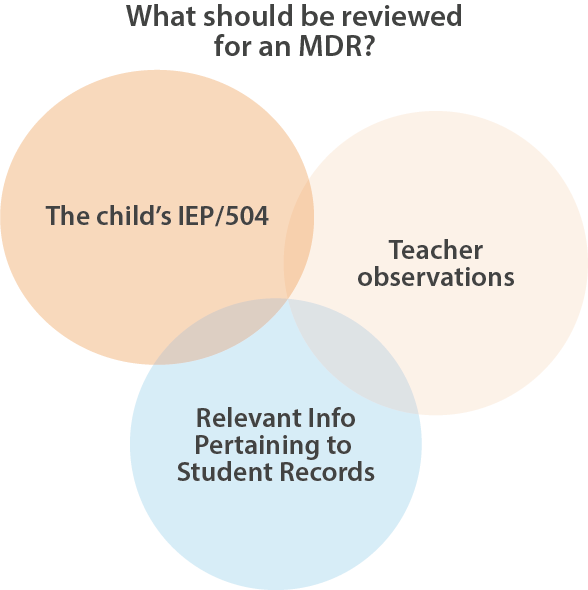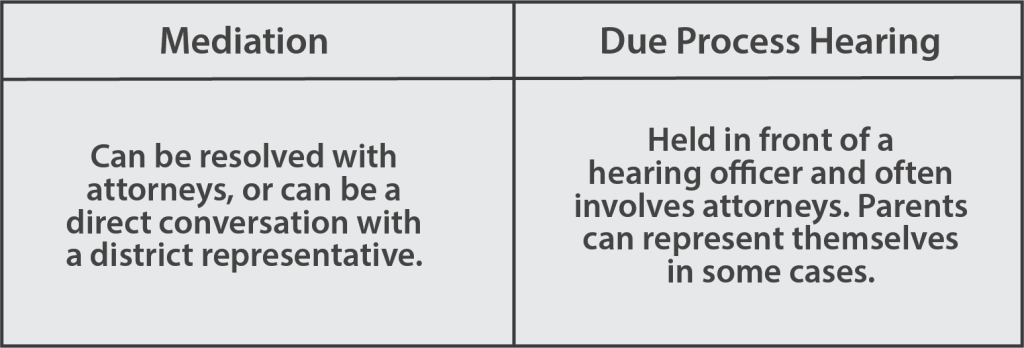What is a Manifestation Determination?
A manifestation determination is a disciplinary procedure for a student with a known or suspected disability who is subject to a disciplinary action that results in a cumulative disciplinary removal (ISS/OSS) for more than 10 school days in their current school year. These procedures apply to students served through the Individuals with Disabilities Education Act (IDEA) or Section 504 of the Rehabilitation Act (504). The Manifestation determination meeting is a way for the student’s team and parent/guardian to determine if the student’s behavior is a manifestation of the child’s disability. This procedure is outlined by IDEA and is a part of a parent/guardian’s procedural safeguards; however, the procedure also applies to students who are identified through 504 or are engaged in the IEP/504 evaluation process.
Ultimately this procedure offers protections to special education students to ensure that they are not unjustly removed from their special education services or educational placement. The manifestation determination also helps to make sure that the school district is providing a free and appropriate public education (FAPE) to all students regardless of their disabilities.
Furthermore, the manifestation determination process provides protections to the school district when making the difficult choice to remove a student for the sake of maintaining a safe and productive learning environment. This protection comes when a district strictly follows the manifestation determination review (MDR) process.
IDEA, Section 1415 (k) (1) (E) (i), states “within 10 school days of any decision to change the placement of a child with a disability because of a violation of a code of student conduct, the local educational agency, the parent, and relevant members of the IEP Team (as determined by the parent and the local educational agency) shall review all relevant information in the student’s file…”
As a part of this manifestation determination review (MDR), the following must be reviewed:
- The Child’s Individualized Education Program (IEP)/504
- Teacher Observations
- Any other relevant information (can include, but is not limited to, prior discipline records, previous educational evaluations, medical records, grades, etc.)

Who is protected?
All students identified through IDEA or Section 504 are protected, and if needed, can be eligible for manifestation determination reviews. There are also times when a student is not receiving services through IDEA/504 but are still possibly considered a student with a disability. Specifically, those students identified in Section 300.534 of IDEA. It states that school personnel have knowledge of a child’s disability when:
- “The parent of the child expressed concern in writing to supervisory or administrative personnel of the appropriate educational agency, or a teacher of the child, that the child is in need of special education and related services;”
- “The parent of the child requested an evaluation of the child pursuant to §§300.300 through 300.311; or”
- “The teacher of the child, or other personnel of the LEA, expressed specific concerns about a pattern of behavior demonstrated by the child directly to the director of special education of the agency or to other supervisory personnel of the agency.”
Requirements
As mentioned above, the requirements for this process are both specific and vague, while those two terms do not belong together, in this instance it is true. The law is specific in the sense that it lays out a timeline for when the manifestation determination meeting must be held (within 10 school days of the change in educational placement) and that a review of relevant documents must be conducted (that’s the vague part). Let’s break it down:
- After a student is subject to a disciplinary action that results in a change of placement, the school district is required to complete the following:
- Assemble relevant members of the child’s IEP Team (as determined by the parent and the LEA)
- Review relevant documentation. Again, this is not defined, but as mentioned above can include, but is not limited to: discipline records, educational evaluations, medical records, grades, special or general education teacher observations, related service provider reports, parent reports, etc.
- As a team, analyze the child’s behavior for a pattern of similar behaviors. If, a pattern is present then,
- Determine if the child’s behavior has a substantial relationship to or is the manifestation of the student’s disability.
- Determine if the child’s behavior was the direct result of the LEA’s failure to implement the student’s IEP.

- Regardless of the outcome of the analysis, the LEA is required to provide documentation
- Depending on the outcome of the meeting:
- If the child’s behavior is not determined to be related to the disability, the LEA issues a prior written notice
- If the infraction or pattern of behavior is the direct result of the student’s disability, then the LEA is obligated to initiate a Functional Behavior Assessment (FBA) if one had not been conducted before. After that process is completed, a Behavior Intervention Plan (BIP) is developed, and an IEP meeting is held to integrate the BIP into the IEP.
- If an FBA had been previously conducted, the team should review it and the BIP. The BIP may need to be amended to mitigate the problem behaviors.
- The team, with parent input will consider the educational placement of the child.
- Depending on the outcome of the meeting:
This task does seem a bit daunting, but each State has a documentation form that helps the team meet all the requirements. IEP management software solutions like SpedTrack, have imbedded state forms that help guide practitioners in providing appropriate and adequate documentation for this process.
Placement Decisions
Not every student’s behavior is related to their disability, in fact it often is not. When this is the case, the school district is justified in removing the student from their current placement. Some types of behavior, especially those very serious in nature (i.e. resulting in serious bodily injury, the use or possession of illegal drugs/controlled substance or weapons) will always result in a removal because of laws like the Missouri Safe Schools Act, Texas Safe Schools Act, and Safe Arizona Schools Plan; however, students may still have access to their special education services which is likely to be provided in an interim alternative educational setting. Additionally, some serious offenses may result in a school board hearing to consider expulsion.
In a similar vein, student’s behavior may have been a manifestation of the disability (i.e. classroom disruptions, considered impulsive, for a student with ADHD). When this is the case, the student will often be returned to their educational placement or, if agreed upon by both the LEA and parent/guardian, change the placement to better support the student.
Again, if the placement is restricted, a prior written notice will be issued to ensure the parent/guardian are properly notified of the LEA’s proposed action.
Appeal and Due Process
There are always times that a parent/guardian will not agree with a particular decision made by the school district (LEA); however, parents/guardians have the right to appeal this decision through mediation or a due process complaint.
Mediation is ideally how a district can manage conflict with a student’s family. Mediation can be approached through the use of attorneys as mediators, or just a direct conversation between a district representative, like the Director of Special Education or Superintendent, and the family. If mediation cannot help overcome the disagreement, then the parents may seek a Due Process Hearing. Districts also have the option to seek a Due Process hearing when it is believed that maintaining the student’s current placement would result in injury to the student or others.
Due process proceedings are held in front of a hearing officer, or an Administrative Law Judge (ALJ), and often involve the use of attorneys. While that is often the case, it is becoming more prevalent that parents represent themselves in these procedures.

Special Circumstances (Weapons, Drugs, Alcohol) dictate special procedures. When appeals are made in these instances, an expedited due process hearing is initiated. These hearings are scheduled by the LEA within 20 school days of the date the complaint was filed. The hearing officer is also required to provide a ruling within 10 school days after the hearing.
What’s next
While this was just an overview of manifestation determinations, check back with us next month for an in-depth look at the specific MDR processes and documentation, including examples!

















